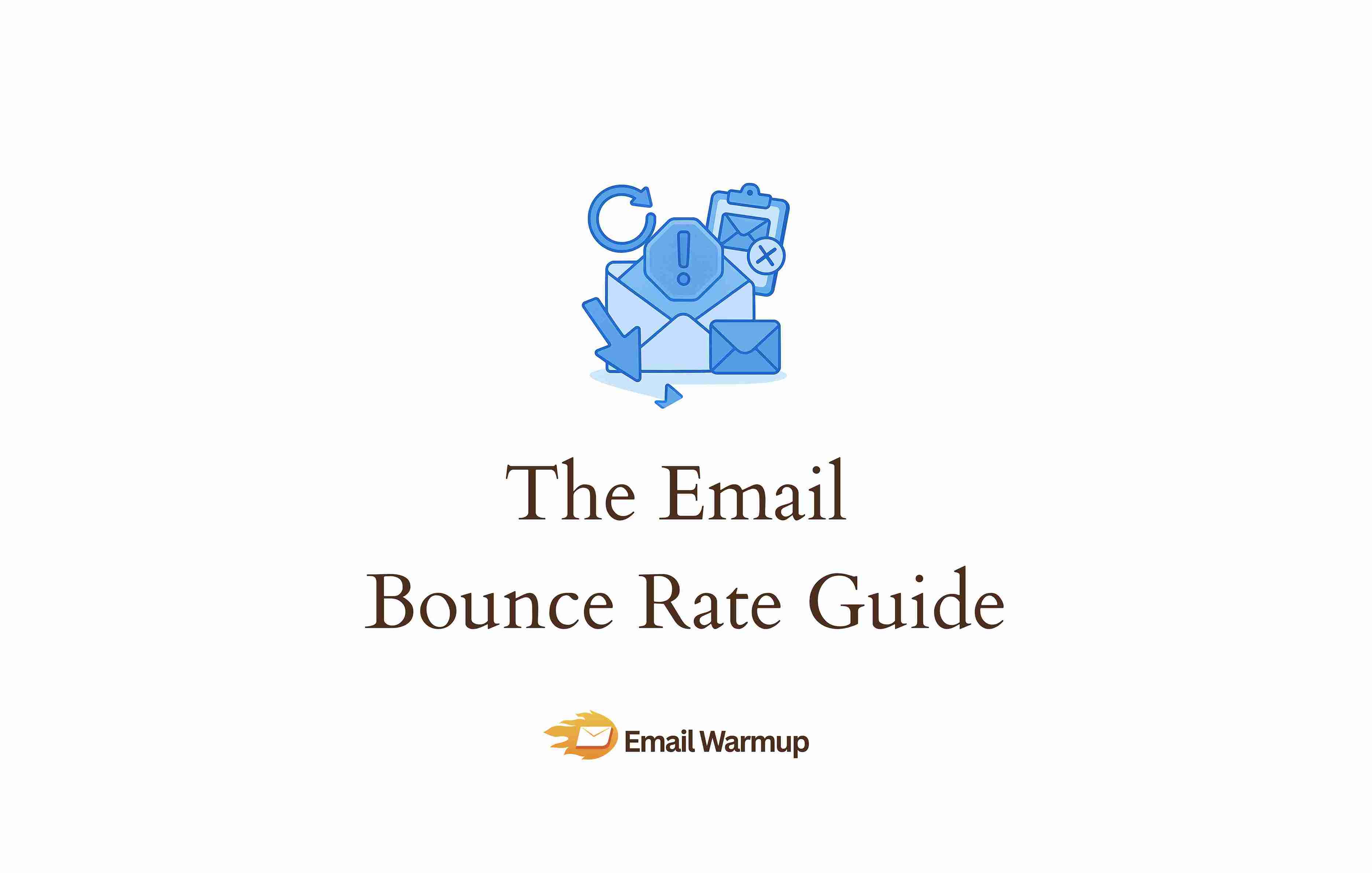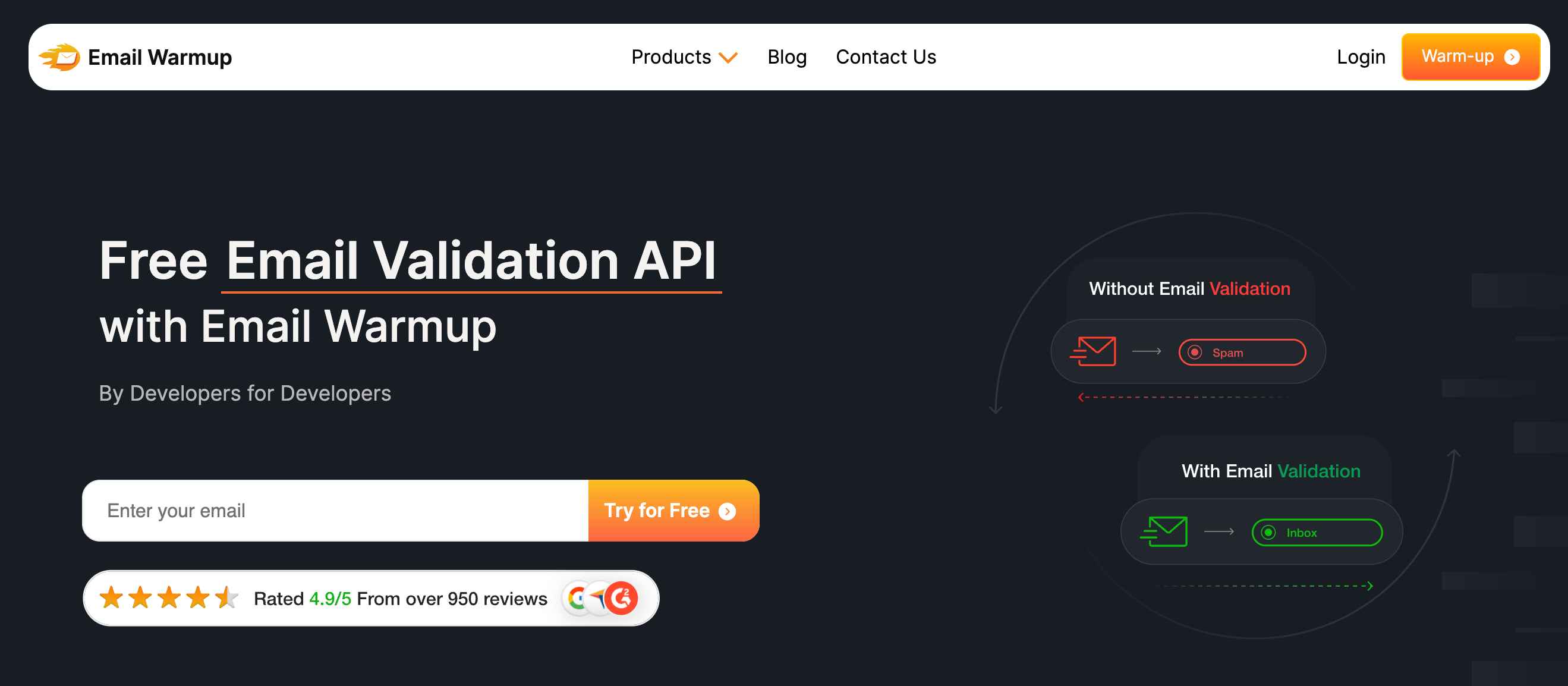
Email bounce rate is the percentage of emails that fail to be delivered to the recipient’s inbox. It’s a very important metric because this can quietly kill your email program. Why? Because every undelivered message:
- Wastes your budget and leads
- Damages your sender reputation
- Lands legitimate emails in spam folders
As an email deliverability consultant who’s helped businesses cut email bounce rates from 8% to under 2% (and watched inbox placement climb to 95%+), I’ve prepped this guide covering:
- What does email bounce rate measure
- The difference between hard and soft bounces
- Seven methods to reduce bounces permanently
- Why is it important to keep track of your bounce rate
Your sender reputation depends on keeping bounces low — and the fixes are simpler than you think.
TLDR: Quick skim — email bounce rate
These benchmarks show you exactly where you stand and when to take action.
| Metric | Definition | Acceptable range | Red flag threshold |
| Bounce rate | Percentage of emails that fail delivery | Below 2% | Above 5% |
| Calculation | (Bounced emails ÷ Total sent) × 100 | — | — |
| Hard bounce | Permanent delivery failure | Should be 0% | Any recurring pattern |
| Soft bounce | Temporary delivery issue | Under 1% | Above 3% |
What is email bounce rate?
Bounce rate measures how many emails fail to reach their destination. When you send 1,000 emails and 40 bounce back, that’s a 4% bounce rate (firmly in the danger zone).
The calculation is straightforward:
Divide bounced emails by total emails sent, then multiply by 100.
If you sent 10,000 emails and 150 bounced, you’re at 1.5% — which falls within acceptable limits.
Emails bounce for dozens of reasons:
- Full recipient inboxes
- Blocked domains or IPs
- Invalid addresses from typos
- Server issues or maintenance
Sometimes the mailbox exists but rejects your message anyway (often because previous senders from your IP damaged its email reputation). That’s why monitoring is very important.
Hard vs. soft bounces — what’s the difference?
Understanding permanent versus temporary failures changes how you handle each type — hard bounces demand immediate action, while soft bounces often resolve themselves.
Hard bounces
Permanent delivery failures happen when the destination doesn’t exist or explicitly blocks you.
Validity’s deliverability research shows that sending to hard bounces repeatedly destroys sender reputation faster than almost anything else.
| Cause | Why it happens | Action required |
| Invalid address | Typo, fake email, deleted account | Remove immediately |
| Non-existent domain | Company closed, domain expired | Remove immediately |
| Permanent block | Server blacklisted your domain | Stop sending, investigate |
Most platforms automatically suppress hard bounces after the first attempt (thankfully), but you should manually review them weekly. Patterns reveal list quality problems before they spiral into reputation disasters.
Soft bounces
Temporary issues cause soft bounces — the recipient’s server is having a bad day, their inbox is full, or your message exceeded size limits.
| Cause | Why it happens | Action required |
| Full inbox | Recipient hasn’t cleared messages | Retry automatically |
| Server temporarily down | Maintenance or technical issue | Retry automatically |
| Message too large | Attachments exceed limits | Reduce size, resend |
Your ESP typically retries soft bounces automatically (Mailchimp up to ~72 hours, though cadence varies by provider). However, if an address soft-bounces consistently across multiple campaigns, treat it like a hard bounce and remove it.
What bounce rate should you aim for?
Industry benchmarks help you gauge whether your list health is acceptable or alarming. Most successful senders maintain bounce rates well under 2% because ISPs start questioning list quality above that threshold.
| Range | Status | Typical cause |
| Under 2% | Healthy | Clean list, good practices |
| 2-5% | Concerning | List aging, need cleaning |
| Above 5% | Critical | Purchased lists or neglect |
| Above 10% | Catastrophic | Severe, can contribute to blocklisting |
Transactional emails should bounce under 1% because recipients just gave you their address. Marketing emails typically bounce slightly higher (1.5-2%) because lists age over time — people change jobs, abandon addresses, and let inboxes fill up.
If your bounce rate consistently exceeds 2%, you’re not just losing reach — you’re actively harming your future inbox placement, according to email marketing benchmarks.
ISPs interpret high bounces as a sign you’re harvesting addresses or ignoring hygiene, then respond by filtering future messages more aggressively.
Why bounce rates destroy your email program
Bounce damage extends far beyond individual failed messages. The ripple effects compound over time, creating a downward spiral that’s expensive to reverse.
Reputation damage
ISPs score your sender reputation based partly on how many emails bounce.
When 8% of your messages fail, providers assume you’re either careless or malicious. Your IP address and domain accumulate negative signals, which affect all future campaigns (even ones sent to valid addresses).

Mailbox providers watch bounce patterns obsessively. Google reports blocking over 15 billion spam emails daily, and separately intercepts 100 million phishing attempts each day. Their filters correlate high bounce rates with spammer behavior because spammers rarely verify addresses before blasting millions of messages. You get lumped in with them when your bounce rate climbs.
Revenue loss
You’re paying to send emails that never deliver. If you’re spending $2,000 monthly on email marketing and 6% of messages bounce, you’ve wasted $120. Multiply that across a year — $1,440 burned on nothing.
The worst part is the opportunity cost. Those bounced messages could have converted 2-3% of recipients into customers (assuming $150 average order value and decent targeting). Instead, they generated zero revenue while damaging your ability to reach everyone else.
The deliverability rate is going down
Bounces trigger what we call the Reputation Death Spiral — high bounce rates lead to IP reputation damage, which causes more messages to hit spam folders, which reduces engagement, which further damages reputation. Breaking this cycle requires months of careful list cleaning and DKIM setup.

Microsoft’s authentication mandate (enforced starting May 5, 2025) makes recovery harder. Non-compliant emails from bulk senders get rejected or junked automatically, and high bounce rates signal non-compliance even when your technical setup is correct.
How to reduce your email bounce rate
Fixing bounce issues requires systematic changes to how you build and maintain your list. EmailToolTester’s research shows that average deliverability sits around 83.1%, meaning 16.9% of marketing emails don’t reach the inbox. These seven methods work together to keep your bounce rate under 2% permanently.
Verify addresses
Real-time verification catches typos and fake addresses at the point of entry. When someone types “gmial.com” instead of “gmail.com” on your signup form, verification tools flag the error immediately (before it pollutes your list).

EmailWarmup.com offers an email validation API that checks addresses in milliseconds. The system verifies syntax, confirms the domain exists, and pings the mailbox to ensure it’s active — all without sending an actual message. You can integrate it directly into signup forms, CRMs, or marketing platforms to stop invalid addresses from ever reaching your database.
Most platforms charge per verification, but the cost is negligible compared to the damage from sending to bad addresses.
Pricing typically ranges from fractions of a cent up to about a cent per check (depending on volume), protecting your sender reputation while avoiding wasted resources on emails that will never deliver.
Remove hard bounces
Never send to an address that has hard-bounced. Ever.
Your ESP should automatically suppress these, but verify it’s working by checking bounce reports weekly.
Create a suppression list that syncs across all sending platforms. An address that hard bounces in Mailchimp should also be blocked in your transactional email system because the problem is the address (not the platform).
Implement double opt-in
Double opt-in confirmation cuts bounce rates dramatically by requiring subscribers to click a verification link after signing up.
Case studies show you may lose about 20-40% of initial signups (they never confirm), but the addresses you keep are verified and engaged. Research from Ascentrik shows double opt-in lists produce substantially better engagement and far fewer bounces.
The tradeoff is worth it. A list of 8,000 confirmed subscribers who open your emails beats a list of 10,000 unverified addresses where 15% bounce and another 30% never engage. ISPs reward engagement (not list size).
Clean inactive subscribers
Addresses that haven’t opened or clicked in 6-12 months should be removed or re-engaged through a win-back campaign.

Many will eventually become hard bounces (people abandon email addresses constantly), but they damage reputation even before they bounce by signaling low engagement. Litmus data confirms that segmented lists produce much better engagement and fewer spam complaints.
Set up automated workflows that flag subscribers who haven’t engaged in 90 days. Send them a re-engagement series, and if they still don’t respond after 3-4 emails, remove them from your list.
Your email deliverability improves immediately when you stop sending to unengaged addresses.
Never buy lists
Purchased lists always have high bounce rates.
Vendors compile addresses through web scraping, data breaches, or outdated business directories — none of which guarantee that the addresses are current and valid. You’ll hit 10-15% bounce rates minimum, and ISPs will blacklist you within days.
Even “verified” purchased lists contain spam traps (addresses ISPs plant specifically to catch bad senders). One hit on a spam trap can tank sender reputation for months.
Set up authentication
SPF, DKIM, and DMARC don’t directly prevent bounces, but they prevent emails from being rejected as spoofed or fraudulent.
Authentication failures commonly produce hard-bounce rejections (5xx status codes) rather than soft bounces. Without proper authentication, receiving servers assume you’re a scammer and reject messages.

Validity’s DMARC analysis shows that a large share of domains still lack strict DMARC protection — which increases filtering risk.
Microsoft now requires authentication for bulk senders, and non-compliant emails get rejected with error code 550 5.7.515. Setting up DMARC takes 30 minutes but protects you from automatic rejection by major providers.
Monitor bounce patterns
Sudden spikes in soft bounces often indicate delivery problems (not list quality issues).
If your bounce rate jumps from 1.5% to 4% overnight, check whether a major provider is experiencing infrastructure problems or whether your sending IP has been temporarily blocked.
Google Postmaster Tools and similar monitoring platforms help you spot reputation issues before they escalate.
Create alerts that notify you when bounce rates exceed normal thresholds. Catching problems early — before you send to your entire list — prevents reputation damage that takes weeks to repair.
Stop leaving money on the table.
Every bounced email represents wasted budget and lost opportunity, but bounce issues are completely fixable with the right tools and expertise.
EmailWarmup.com helps businesses maintain bounce rates under 2% while maximizing inbox placement:
AI-guided warmups mirror your real campaigns — curated by expert copywriters to raise inbox rates.
See inbox vs spam in Gmail/Outlook with our free extension and sent-folder labels for each email.
Run unlimited tests across 50+ mailbox providers with clear inbox, promotions, and spam breakdowns.
Free 1:1 experts who fix SPF/DKIM/DMARC, blacklist issues, segmentation without any limits, or upsells.
Strategy, audits, and campaign optimization to grow opens, clicks, and revenue end-to-end.
Verify the email addresses in your lists with fast and accurate checks, using REST/JSON, SDKs in 8 languages, and 100 free credits for testing.
Frequently asked questions
Here are some commonly asked questions about email spam filters:
Yes. ISPs interpret high bounce rates as a signal that you’re scraping addresses or ignoring list hygiene. When bounce rate exceeds 5%, providers apply stricter filtering to all messages — even ones sent to valid addresses. Your legitimate emails start landing in spam, creating a cascade of deliverability problems.
Clean quarterly at minimum, but monthly works better for high-volume senders. Remove hard bounces immediately and suppress addresses that haven’t engaged in 6-12 months. B2B lists age faster because people change jobs frequently, while consumer lists stay stable longer.
Bounced emails aren’t counted in the “delivered” metric that calculates open rates. However, reputation damage from high bounces causes more delivered messages to land in spam folders, which tanks open rates. Fix bounce rate and you’ll see open rates climb within 2-3 campaigns.
Bounces are far more damaging. Unsubscribes signal that real people received your message and chose to opt out (which ISPs view neutrally or positively). Bounces signal you’re sending to invalid addresses, which ISPs interpret as a red flag. A 2% unsubscribe rate is acceptable, while a 2% bounce rate is the maximum threshold.
Yes, but it requires aggressive action. Immediately stop all campaigns and verify every address using a validation service. Remove all hard bounces and any address that hasn’t engaged in 90+ days. Implement double opt-in for new signups. After cleaning, start with small batches to rebuild the sender’s reputation slowly. Recovery typically takes 4-8 weeks.
References
- Google Help. (2025). Email sender guidelines.
- Ascentrik. (2024). Double opt-ins and single opt-ins.
- Validity. (2024). The state of email in 2024: Keeping ahead of the curve.
- Moosend. (2025). Email marketing benchmarks by industry, region and day.
- Validity. (2024). DMARC adoption: A deep dive into the current state of email authentication.
- Mailgun. (2025). Google postmaster tools startup guide: Sender reputation.
- EmailToolTester. (2025). Email deliverability statistics.
- Litmus. (2024). The state of email trends report.
